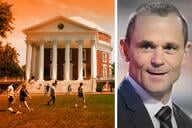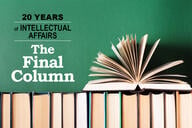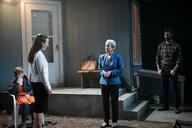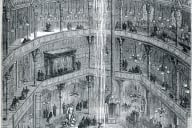You have /5 articles left.
Sign up for a free account or log in.
“Everyone is entitled to his own opinions,” the sociologist and politico Daniel Patrick Moynihan said, “but not to his own facts.” He may have been improving upon a similar if less trenchant remark (“ …but no man has a right to be wrong in his facts”) attributed to the financier Bernard Baruch.
Until sitting down to write this I did not know about Baruch’s version. A certainty that my eagle-eyed editor would inquire about the source obliged me to vet the attribution to Moynihan; she requires more than my vague recollection of having read it somewhere. In checking my facts, she bolsters my conscience, enforcing Moynihan’s (and Baruch’s) point about accountability.
Lucas Graves, an assistant professor of journalism and mass communication at the University of Wisconsin at Madison, uses the expression “internal fact-checking” to describe this kind of preventative, behind-the-scenes work. It tries “to eliminate untruth, not call attention to it” by catching and correcting mistakes in an article before it goes to press. In Deciding What’s True: The Rise of Political Fact-Checking in American Journalism (Columbia University Press), Graves traces how internal fact-checking morphed into something almost antithetical: the very public evaluation of factual assertions made by politicians and other figures in the news.
News organizations such as PolitiFact, FactCheck.org and The Washington Post’s Fact Checker -- to name only the most nationally prominent -- intervene so frequently in American public discourse now that it seems counterintuitive to think they’ve only recently become a force in the world. Until the last two or three presidential election cycles, scrutiny of a candidate’s claims tended to be episodic and ad hoc -- and often enough conducted by the opposing campaign, bringing its own biases to the process. To the ethos of newspaper editors and reporters circa 1950, the idea of confirming or debunking a public figure’s statements of fact seemed perilously close to an expression of opinion, to be avoided at the risk of compromising one’s reputation for objectivity. Reporting that a fact was in dispute might be acceptable in some cases, but making a judgment call on it was best left to the pundits and thumb suckers.
The title Deciding What’s True is clearly an homage to Deciding What’s News by Herbert J. Gans, a classic study of newsroom culture, and Graves followed in his predecessor’s participant-observer footsteps by working for two major fact-checking organizations between 2010 and 2012. The book thus benefits from having two vantage points: the historical and sociological perspective available from media-studies scholarship, plus close ethnographic observation of how major fact-checking stories are discovered, investigated, debated in-house before being sent out to make their mark on the world.
His most striking insight, it seems to me, is how specific, self-defined and virtually self-contained the world of professionalized fact-checking tends to be. The naïve observer might think of fact-checking organizations as being akin to media watchdog groups such as the Media Research Center on the right and Media Matters for America to the left, with PolitiFact falling somewhere in between. But in reality the fact-checking milieu sees itself as unrelated to the partisan watchdog groups: it doesn’t work with or quote them, and Graves recounts one fact-checker as saying he almost decided to kill an investigation when he saw that Media Matters was already interested in it. Likewise, fact-checking journalists see a bright line between their work and blogging.
This is not just a matter of professional amour propre. The major fact-checking organizations have ties to established media institutions, including journalism schools, and retain a belief (which watchdogs and bloggers alike tend to reject) in old newsroom ideals of objectivity, impartiality and conscientious reporting.
The ’00s put confidence in those ideals under enormous strain from a number of catastrophically bad judgment calls (reporting war propaganda and Wall Street shilling without due diligence) as well as cases of plagiarism or outright fabrication in major news publications. Compounding those problems, even inducing some of them, was the growing array of new media competing for public attention while also driving up the pace of the news cycle.
In an email exchange with Graves, I indicated that PolitiFact, Fact Checker and so on seemed like a response, in part, to the 24-hour news cycle that emerged around the time of the first Gulf War and intensified still more once the internet started to permeate everyday life. Rumors, misinformation and bogus statistics could spread faster, and farther, than ever before.
Graves agreed, but added, “Another way to think about that is that the traditional model of objectivity, for all of its flaws, made some sense in a world where professional journalists acted as gatekeepers and could effectively police the borders of political discourse. Then wild rumors about the president’s birthplace didn’t have to be debunked because they could be denied coverage altogether. But the opening up of political discourse after the 1960s and the fragmentation of the media beginning in the 1990s -- both healthy developments in many ways, and both with echoes in the 19th century -- also effectively spelled the end of the journalist as gatekeeper. And especially with the rise of the internet, that fragmentation calls for a more critical style of political reporting that’s willing to directly challenge false claims.”
In principle, at least, systematic and high-quality fact-checking ought to make politicians and other public figures more careful about the claims they make while giving the public a running lesson in critical thought at the same time. At times, Deciding What’s True seems to encourage that hope. But I’ve been reading the book between rounds of binge-watching campaign coverage, and it is not an experience to recommend. The idea that fact-checking can impose some kind of restraint on a candidate, or influence public response, seems utterly negated by the candidacy of Donald Trump. His well-documented but unrelenting dishonesty -- his talent for lying without restraint or regard for evidence, outright and brazenly, even after the facts have been shown repeatedly -- never wavers yet makes no dent in his level of support. This seems really strange.
“This a large and complicated question,” Graves responded, “and people who study journalism and political communication are trying to approach it in many different ways. But one answer is that there have always been fairly wide slices of the American electorate that are deeply suspicious of establishment discourse, sometimes with good reason. If you listen to Trump supporters in interviews, they seem to accept that he doesn’t have the grasp of policy that other politicians do, and they don’t necessarily believe everything he says or subscribe to all of his views. He seems to say whatever he thinks and embrace a common-sense approach that many people find appealing. Beyond that, none of us makes political calculations in the detached, rational way that political theorists sometimes imagine.
“And at the same time, fact-checking has made a difference,” Graves continued. “It arguably has helped to solidify the ceiling over Trump’s support, giving ammunition to both voters and politicians who say they’ll never back him. And it has had a tremendous influence on coverage of his campaign, with front-page articles on Trump’s extraordinary disregard for the facts and constant references to his falsehoods even in straight news reports. We have nothing to compare this race to, and it’s impossible to say where this thing would be if more journalists had stuck to the traditional ‘he said, she said’ formula.”




